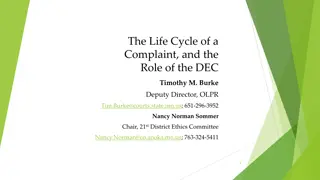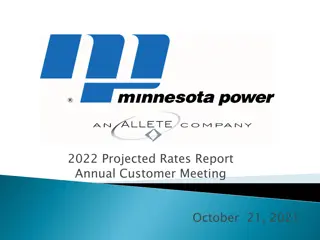Changes in Minnesota School Finance Context Since 2011 Report
Explore the changes in Minnesota's school finance context post the 2011 Working Group Report by Tom Melcher. Topics include funding adjustments, basic formula increases, literacy aid introduction, small schools aid implementation, and one-time compensatory aid for FY 2013.
Download Presentation

Please find below an Image/Link to download the presentation.
The content on the website is provided AS IS for your information and personal use only. It may not be sold, licensed, or shared on other websites without obtaining consent from the author.If you encounter any issues during the download, it is possible that the publisher has removed the file from their server.
You are allowed to download the files provided on this website for personal or commercial use, subject to the condition that they are used lawfully. All files are the property of their respective owners.
The content on the website is provided AS IS for your information and personal use only. It may not be sold, licensed, or shared on other websites without obtaining consent from the author.
E N D
Presentation Transcript
Changes in Minnesota School Finance Context Since Working Group Report Issued in May 2011 Tom Melcher June 25, 2012
Topics for Discussion Funding Changes: Basic Formula Literacy Aid Small Schools Aid One-Time Compensatory Aid Other Integration (Sunset and Task Force Recommendations) Aid Payment and Property Tax Levy Shifts Alternative Compensation Participation Approaching Cap Staff Development Needs (Teacher/Principal Evaluation) State General Fund Budget Outlook for FY 2014 FY 2015 2
Basic Formula FY 2012: $50 (1%) increase, from $5,124 to $5,174 FY 2013: Additional $50 increase, from $5,174 to $5,224 Inflation Projections for FY 2012 and FY 2013: CPI: 2.7% for FY 2012; 1.4% for FY 2013 IPD: 2.5% for FY 2012; 1.7% for FY 2013 3
Literacy Aid Begins in FY 2013 Includes Proficiency Aid and Growth Aid Proficiency aid = $530 x grade 3 enrollment on October 1 of the previous year x three year average percent of third graders proficient on third grade reading MCA. Growth aid = $530 x grade 4 enrollment on October 1 of the previous year x three year average percent of fourth graders making medium or high growth on the reading MCA. For FY 2013 only, state total aid is capped at $48,585,000 (97.8% proration projected) 4
Small Schools Aid New component of general education revenue, beginning in FY 2013. School districts with fewer than 1,000 AMCPU qualify for revenue on a sliding scale: Allowance / AMCPU = $522.40 x (1,000 AMCPU) / 1,000 Charter schools are not eligible for this revenue. 5
One-Time Compensatory Aid One-time aid for FY 2013. The 20 largest districts in the state are eligible for this aid if their regular compensatory revenue per compensatory pupil unit (free + of reduced price lunch count) is less than $1,400 per compensatory pupil unit. The aid equals the amount needed to bring the district s compensatory aid up to the $1,400 level. This revenue must be used for basic skills purposes as defined in Minn. Stat. 126C.15, subdivision 1. The allocation by building is to be determined locally. 7
One-Time Compensatory Aid February 2012 Forecast Estimates Current Comp. $/ Adj Count (Free + 1/2 Red.) Additional $ /Adj Count to Reach $1,400 1,158 Poverty Conc. Estimated Revenue 685,441 1,113,551 1,018,097 1,137,581 1,102,436 1,527,203 2,910,280 1,666,751 2,551,260 482,603 347,220 276MINNETONKA 194LAKEVILLE 112EASTERN CARVER CO. 284WAYZATA 272EDEN PRAIRIE 728ELK RIVER 196ROSEMOUNT 833SOUTH WASHINGTON CO. 11ANOKA-HENNEPIN 621MOUNDS VIEW 535ROCHESTER 6% 11% 14% 15% 18% 19% 18% 17% 27% 27% 31% 242 448 630 666 743 764 804 831 1,156 1,224 1,332 952 770 734 657 636 596 569 244 176 68 9
One-Time Compensatory Aid February 2012 Forecast Estimates Current Comp. $/ Adj Count (Free + 1/2 Red.) 1,502 1,561 1,565 1,744 1,748 1,778 1,939 2,475 2,572 Additional $ /Adj Count to Reach $1,400 Poverty Conc. 37% 41% 35% 34% 42% 44% 44% 63% 69% Estimated Revenue 191BURNSVILLE 622NORTH ST PAUL-MAPLE. 271BLOOMINGTON 279OSSEO 281ROBBINSDALE 742ST. CLOUD 709DULUTH 1.2MINNEAPOLIS 625ST. PAUL 0 0 0 0 0 0 0 0 0 0 0 0 0 0 0 0 0 0 10
Other Funding Formula Changes 2011 Legislation Permanent School Fund / Endowment Charter schools eligible for payments (~$28/ADM); Funds allocated on adjusted ADM instead of resident ADM Training & Experience Revenue repealed Late Contract Penalty repealed Early Graduation Scholarships / Military Service Awards Charter school lease aid grandfather and state charter school startup aid repealed 11
Integration Revenue 2011 Legislation The current integration funding formula remains in effect through FY 2013. Integration revenue statute is repealed beginning in FY 2014; however, funding for a replacement program remains in the base budget for FY 2014 and FY 2015 The current integration rule remains in effect with no sunset. Interdistrict desegregation transportation funding remains in the base for FY 2014 and later Integration Revenue Replacement Advisory Task Force established to develop recommendations for repurposing integration revenue 12
Integration Revenue Task Force Recommendations 1. Create the Achievement and Integration for Minnesota (AIM) program funded through existing categorical revenue.. 2. Ensure accountability and oversight at the Department (MDE) 3. Clearly focus and define limited uses of AIM revenue 4. Examine the merits of one collaborative Metropolitan Integration School District .. 13
Integration Revenue Task Force Recommended Fiscal Principles 1. Cap the existing revenue program at the current level. 2. Level the fiscal disparities between demographically similar districts: Reduce the disproportionality between tiers starting in FY 14. Create incentives for districts to cooperate to reduce racial enrollment disparities using voluntary measures (public school choice). 3. Set aside .02 percent (%) of revenue to ensure oversight and accountability at the Minnesota Department of Education. MDE will withhold revenue for districts not making progress towards goals. 14
Integration Revenue Task Force Recommended Fiscal Principles (Continued) 4. Create a fiscal model that is predictable over time and stable in two-year increments. 5. Define percentages of allowable expenditures in statute: At least 80 percent (%) of revenue is spent on students. Twenty percent (20%) spent on professional development and administration. Administrative costs may not exceed 10 percent (%). 15
School Shift Summary February 2012 Forecast Aid Payment Shift @ 64.3 35.7 (vs 90-10) $1.873 Billion Property Tax Shift (@ 48.6% of Gross Levy) $563 Million _____________ Total School Shift (as of 6/30/2013) $2.436 Billion 16
Repayment of School Shifts M.S. 16A.152 requires unrestricted state general fund budget balances to be allocated in the following order: 1. $350 Million to state s cash flow account 2. $653 million to state s budget reserve account 3. Pay back school aid payment shift 4. Pay back school tax shift Current payment percent remains at 64.3% to begin FY 2013 Re-evaluated with November forecast: If state budget improves, increase current percent ($73 M for each 1% increase) If state budget gets worse, current percent remains 64.3 unless changed by legislation
Alternative Teacher Compensation Status Update MS 126C.10, Subd. 34, limits state total basic alternative teacher compensation (Q Comp) aid to $75,636,000. New teacher evaluation requirements have triggered increased interest. Basic aid was $43,027,000 in FY 2012, and is projected to increase to $49,759,000 in FY 2013 and to $63,425,000 in FY 2014. (FY 2014 projection includes Anoka, Minneapolis, Bloomington, Burnsville and West St Paul, but not St Paul. Adding St Paul would make the total $69,963,000.) When basic aid reaches the cap, MDE will no longer be able to approve new districts, creating an equity issue. A decision will be needed on whether to accept the equity issue, increase the cap, or go with a new approach. 18
Teacher Evaluation Process (2011 Legislation) The annual teacher evaluation process: establishes a three-year professional review cycle and includes at least one summative evaluation performed by a trained evaluator agreed upon teacher value-added assessment models and state and local measures of student growth for 35 percent of teacher evaluation results; student engagement and connection measures requires qualified and trained evaluators to perform summative assessments; requires support to improve the performance of teachers is to be coordinated with staff development activities; may allow time for peer coaching and teacher collaboration; may include mentoring and induction programs;
Teacher Evaluation Process Panel Requires a teacher evaluation process be adopted in all districts. Requires MDE to develop a default model to be used should the district and teachers fail to adopt a model by joint agreement MDE model expected to be ready to present to the Commissioner in December 2012 It will be piloted in school districts during 2013/14 school year Full implementation the 2014/15 school year 20
Principal Evaluation Model Requires each district to adopt and maintain an annual principal evaluation as a duty of the superintendent MDE developed a model that may be used by districts. Model completed and reported to legislature on February 1, 2012 Model to be piloted in 16 school districts during 2012- 13 school year and all districts must implement in 2013/14 school year Requires district to support and provide professional development to improve a principal's instructional leadership and organizational management skills 21
Staff Development Needs (Teacher/Principal Evaluation) What will be the implementation and staff development costs for both the Principal and Teacher evaluation processes? Trained evaluators Assessment costs (35%) Staff Development requirements Cost of surveys (principal s, student connectedness) 22
State General Fund Budget End of 2012 Legislative Session ($ in millions) FY 2012-13 FY 2014-15 Beginning Balance Revenues Spending* Balance before Reserves 1,068 26 Cash Flow Account Budget Reserve Stadium Reserve 34 Budget Balance $ 26 $1,289 33,867 34,086** $ 1,068 35,861 36,902 350 653 350 653 66 ($1,047) * Net spending after school shifts ** Reflects $318 million K-12 Education shift buyback 23
Questions? For general questions, please contact: Tom Melcher, Director School Finance Division 651-582-8828 tom.melcher@state.mn.us For full text of report and district-by-district runs: See MDE web site at: http://education.state.mn.us/MDE/Welcome/AdvBCT/EducFi nanWork/index.html 24























